The Leadership Experience Essay - Exploring Leadership Theories
VerifiedAdded on 2019/10/30
|9
|2723
|148
Essay
AI Summary
This essay delves into the multifaceted realm of leadership, examining its evolution from traditional models to contemporary approaches. It explores various leadership theories, including the Great Man Theory, Trait Theory, Behavior Theory, Contingency Theory, Influence Theory, and Relational Theories, highlighting their significance in understanding leadership dynamics. The essay emphasizes the importance of adaptability, collaboration, and employee empowerment in modern leadership, contrasting it with outdated notions of control and rigidity. It analyzes the shift from hierarchical structures to more inclusive and diverse workplaces, where leaders act as facilitators, fostering teamwork and open communication. The author draws upon the work of Daft to underscore the significance of soft skills, emotional intelligence, and the ability to inspire and motivate teams, ultimately advocating for a leadership style that prioritizes change, empowerment, and relational approaches to drive organizational success.
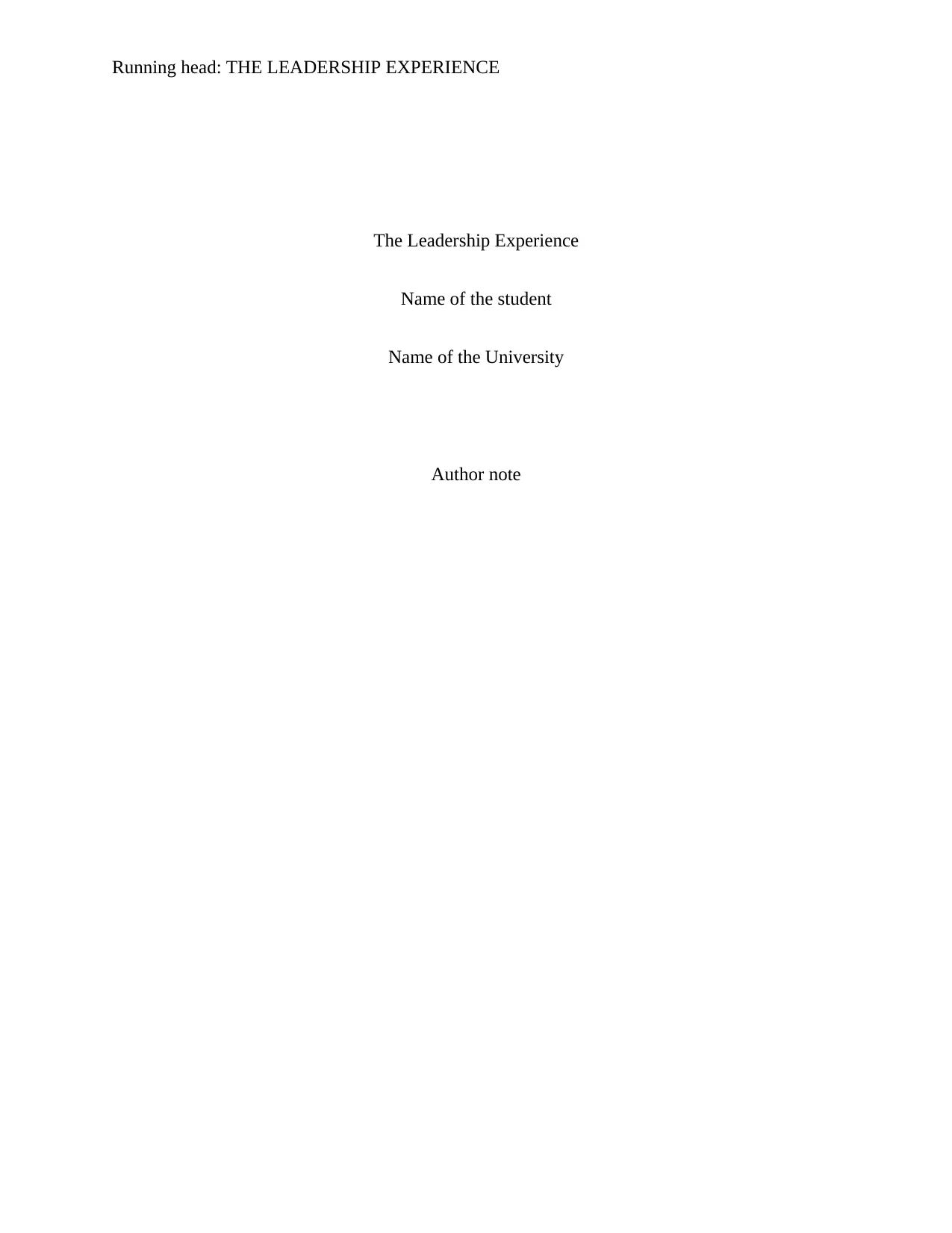
Running head: THE LEADERSHIP EXPERIENCE
The Leadership Experience
Name of the student
Name of the University
Author note
The Leadership Experience
Name of the student
Name of the University
Author note
Paraphrase This Document
Need a fresh take? Get an instant paraphrase of this document with our AI Paraphraser
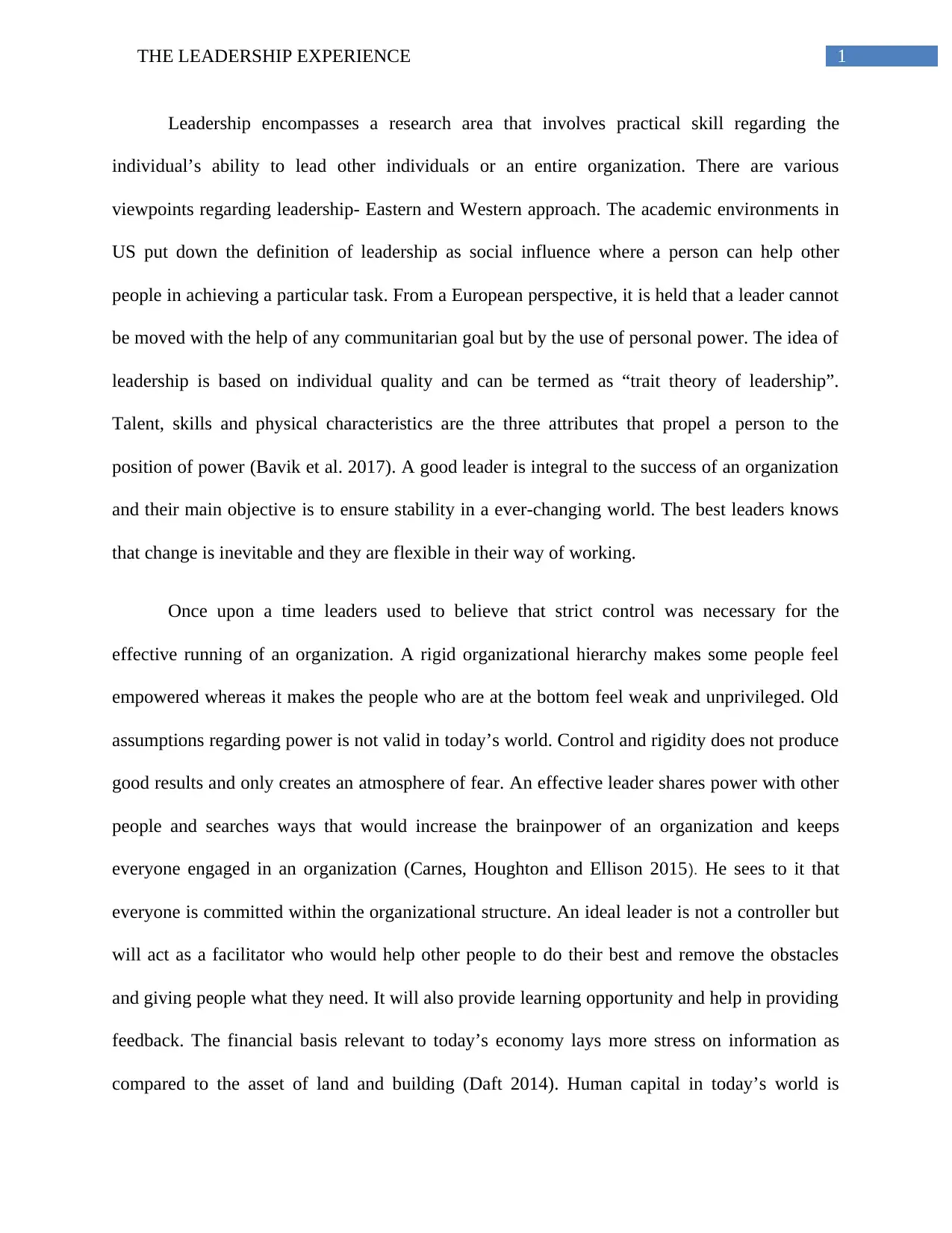
1THE LEADERSHIP EXPERIENCE
Leadership encompasses a research area that involves practical skill regarding the
individual’s ability to lead other individuals or an entire organization. There are various
viewpoints regarding leadership- Eastern and Western approach. The academic environments in
US put down the definition of leadership as social influence where a person can help other
people in achieving a particular task. From a European perspective, it is held that a leader cannot
be moved with the help of any communitarian goal but by the use of personal power. The idea of
leadership is based on individual quality and can be termed as “trait theory of leadership”.
Talent, skills and physical characteristics are the three attributes that propel a person to the
position of power (Bavik et al. 2017). A good leader is integral to the success of an organization
and their main objective is to ensure stability in a ever-changing world. The best leaders knows
that change is inevitable and they are flexible in their way of working.
Once upon a time leaders used to believe that strict control was necessary for the
effective running of an organization. A rigid organizational hierarchy makes some people feel
empowered whereas it makes the people who are at the bottom feel weak and unprivileged. Old
assumptions regarding power is not valid in today’s world. Control and rigidity does not produce
good results and only creates an atmosphere of fear. An effective leader shares power with other
people and searches ways that would increase the brainpower of an organization and keeps
everyone engaged in an organization (Carnes, Houghton and Ellison 2015). He sees to it that
everyone is committed within the organizational structure. An ideal leader is not a controller but
will act as a facilitator who would help other people to do their best and remove the obstacles
and giving people what they need. It will also provide learning opportunity and help in providing
feedback. The financial basis relevant to today’s economy lays more stress on information as
compared to the asset of land and building (Daft 2014). Human capital in today’s world is
Leadership encompasses a research area that involves practical skill regarding the
individual’s ability to lead other individuals or an entire organization. There are various
viewpoints regarding leadership- Eastern and Western approach. The academic environments in
US put down the definition of leadership as social influence where a person can help other
people in achieving a particular task. From a European perspective, it is held that a leader cannot
be moved with the help of any communitarian goal but by the use of personal power. The idea of
leadership is based on individual quality and can be termed as “trait theory of leadership”.
Talent, skills and physical characteristics are the three attributes that propel a person to the
position of power (Bavik et al. 2017). A good leader is integral to the success of an organization
and their main objective is to ensure stability in a ever-changing world. The best leaders knows
that change is inevitable and they are flexible in their way of working.
Once upon a time leaders used to believe that strict control was necessary for the
effective running of an organization. A rigid organizational hierarchy makes some people feel
empowered whereas it makes the people who are at the bottom feel weak and unprivileged. Old
assumptions regarding power is not valid in today’s world. Control and rigidity does not produce
good results and only creates an atmosphere of fear. An effective leader shares power with other
people and searches ways that would increase the brainpower of an organization and keeps
everyone engaged in an organization (Carnes, Houghton and Ellison 2015). He sees to it that
everyone is committed within the organizational structure. An ideal leader is not a controller but
will act as a facilitator who would help other people to do their best and remove the obstacles
and giving people what they need. It will also provide learning opportunity and help in providing
feedback. The financial basis relevant to today’s economy lays more stress on information as
compared to the asset of land and building (Daft 2014). Human capital in today’s world is
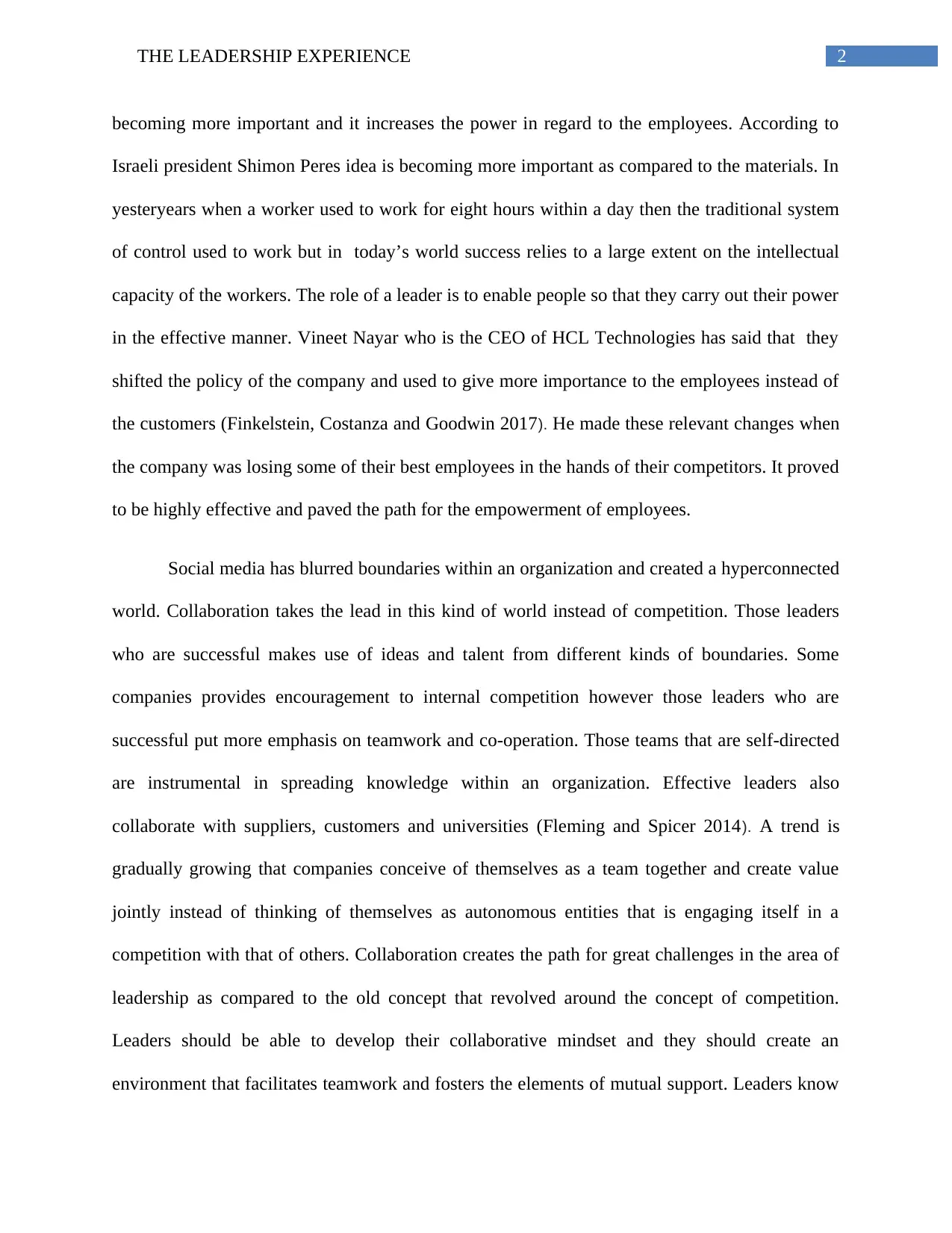
2THE LEADERSHIP EXPERIENCE
becoming more important and it increases the power in regard to the employees. According to
Israeli president Shimon Peres idea is becoming more important as compared to the materials. In
yesteryears when a worker used to work for eight hours within a day then the traditional system
of control used to work but in today’s world success relies to a large extent on the intellectual
capacity of the workers. The role of a leader is to enable people so that they carry out their power
in the effective manner. Vineet Nayar who is the CEO of HCL Technologies has said that they
shifted the policy of the company and used to give more importance to the employees instead of
the customers (Finkelstein, Costanza and Goodwin 2017). He made these relevant changes when
the company was losing some of their best employees in the hands of their competitors. It proved
to be highly effective and paved the path for the empowerment of employees.
Social media has blurred boundaries within an organization and created a hyperconnected
world. Collaboration takes the lead in this kind of world instead of competition. Those leaders
who are successful makes use of ideas and talent from different kinds of boundaries. Some
companies provides encouragement to internal competition however those leaders who are
successful put more emphasis on teamwork and co-operation. Those teams that are self-directed
are instrumental in spreading knowledge within an organization. Effective leaders also
collaborate with suppliers, customers and universities (Fleming and Spicer 2014). A trend is
gradually growing that companies conceive of themselves as a team together and create value
jointly instead of thinking of themselves as autonomous entities that is engaging itself in a
competition with that of others. Collaboration creates the path for great challenges in the area of
leadership as compared to the old concept that revolved around the concept of competition.
Leaders should be able to develop their collaborative mindset and they should create an
environment that facilitates teamwork and fosters the elements of mutual support. Leaders know
becoming more important and it increases the power in regard to the employees. According to
Israeli president Shimon Peres idea is becoming more important as compared to the materials. In
yesteryears when a worker used to work for eight hours within a day then the traditional system
of control used to work but in today’s world success relies to a large extent on the intellectual
capacity of the workers. The role of a leader is to enable people so that they carry out their power
in the effective manner. Vineet Nayar who is the CEO of HCL Technologies has said that they
shifted the policy of the company and used to give more importance to the employees instead of
the customers (Finkelstein, Costanza and Goodwin 2017). He made these relevant changes when
the company was losing some of their best employees in the hands of their competitors. It proved
to be highly effective and paved the path for the empowerment of employees.
Social media has blurred boundaries within an organization and created a hyperconnected
world. Collaboration takes the lead in this kind of world instead of competition. Those leaders
who are successful makes use of ideas and talent from different kinds of boundaries. Some
companies provides encouragement to internal competition however those leaders who are
successful put more emphasis on teamwork and co-operation. Those teams that are self-directed
are instrumental in spreading knowledge within an organization. Effective leaders also
collaborate with suppliers, customers and universities (Fleming and Spicer 2014). A trend is
gradually growing that companies conceive of themselves as a team together and create value
jointly instead of thinking of themselves as autonomous entities that is engaging itself in a
competition with that of others. Collaboration creates the path for great challenges in the area of
leadership as compared to the old concept that revolved around the concept of competition.
Leaders should be able to develop their collaborative mindset and they should create an
environment that facilitates teamwork and fosters the elements of mutual support. Leaders know
⊘ This is a preview!⊘
Do you want full access?
Subscribe today to unlock all pages.

Trusted by 1+ million students worldwide
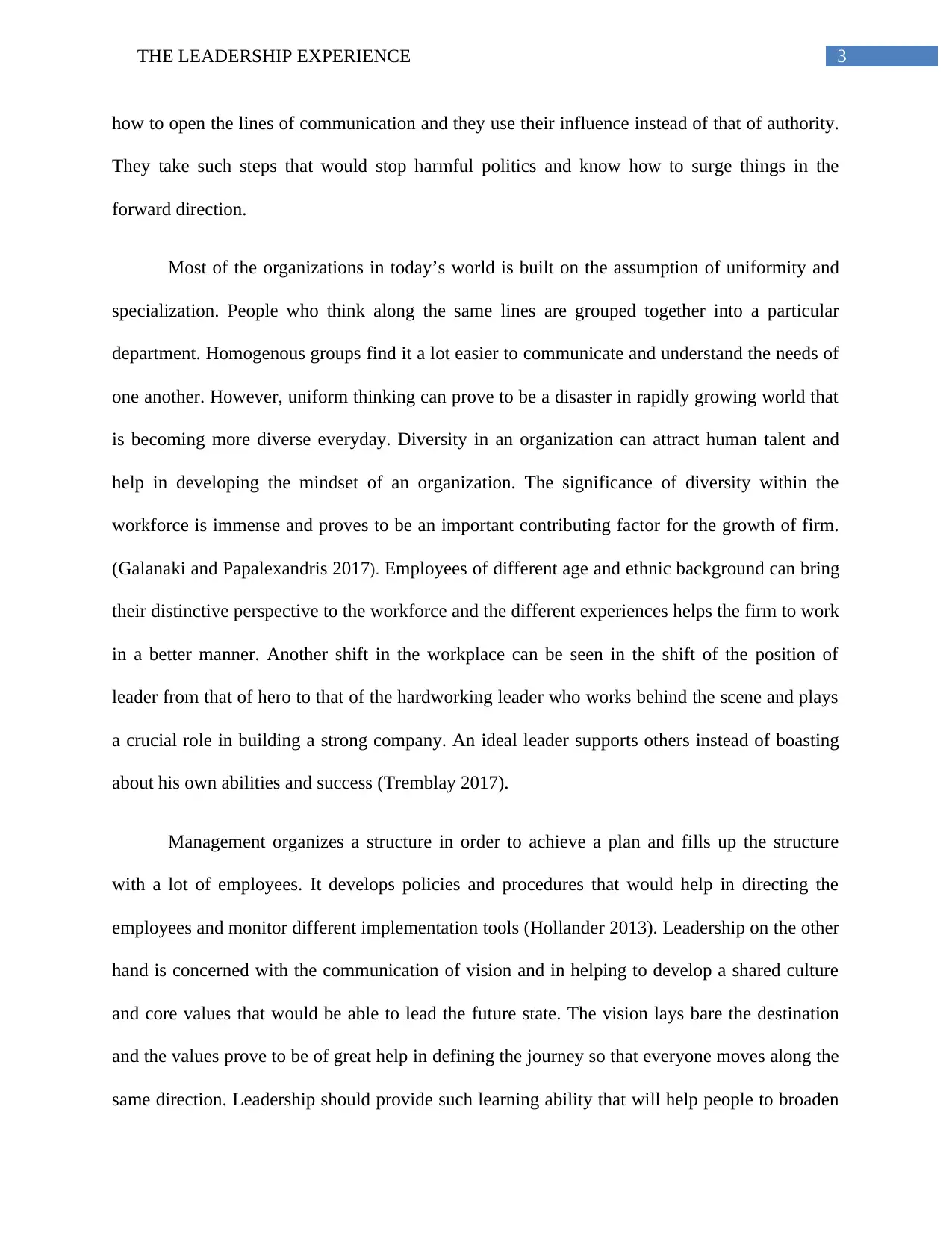
3THE LEADERSHIP EXPERIENCE
how to open the lines of communication and they use their influence instead of that of authority.
They take such steps that would stop harmful politics and know how to surge things in the
forward direction.
Most of the organizations in today’s world is built on the assumption of uniformity and
specialization. People who think along the same lines are grouped together into a particular
department. Homogenous groups find it a lot easier to communicate and understand the needs of
one another. However, uniform thinking can prove to be a disaster in rapidly growing world that
is becoming more diverse everyday. Diversity in an organization can attract human talent and
help in developing the mindset of an organization. The significance of diversity within the
workforce is immense and proves to be an important contributing factor for the growth of firm.
(Galanaki and Papalexandris 2017). Employees of different age and ethnic background can bring
their distinctive perspective to the workforce and the different experiences helps the firm to work
in a better manner. Another shift in the workplace can be seen in the shift of the position of
leader from that of hero to that of the hardworking leader who works behind the scene and plays
a crucial role in building a strong company. An ideal leader supports others instead of boasting
about his own abilities and success (Tremblay 2017).
Management organizes a structure in order to achieve a plan and fills up the structure
with a lot of employees. It develops policies and procedures that would help in directing the
employees and monitor different implementation tools (Hollander 2013). Leadership on the other
hand is concerned with the communication of vision and in helping to develop a shared culture
and core values that would be able to lead the future state. The vision lays bare the destination
and the values prove to be of great help in defining the journey so that everyone moves along the
same direction. Leadership should provide such learning ability that will help people to broaden
how to open the lines of communication and they use their influence instead of that of authority.
They take such steps that would stop harmful politics and know how to surge things in the
forward direction.
Most of the organizations in today’s world is built on the assumption of uniformity and
specialization. People who think along the same lines are grouped together into a particular
department. Homogenous groups find it a lot easier to communicate and understand the needs of
one another. However, uniform thinking can prove to be a disaster in rapidly growing world that
is becoming more diverse everyday. Diversity in an organization can attract human talent and
help in developing the mindset of an organization. The significance of diversity within the
workforce is immense and proves to be an important contributing factor for the growth of firm.
(Galanaki and Papalexandris 2017). Employees of different age and ethnic background can bring
their distinctive perspective to the workforce and the different experiences helps the firm to work
in a better manner. Another shift in the workplace can be seen in the shift of the position of
leader from that of hero to that of the hardworking leader who works behind the scene and plays
a crucial role in building a strong company. An ideal leader supports others instead of boasting
about his own abilities and success (Tremblay 2017).
Management organizes a structure in order to achieve a plan and fills up the structure
with a lot of employees. It develops policies and procedures that would help in directing the
employees and monitor different implementation tools (Hollander 2013). Leadership on the other
hand is concerned with the communication of vision and in helping to develop a shared culture
and core values that would be able to lead the future state. The vision lays bare the destination
and the values prove to be of great help in defining the journey so that everyone moves along the
same direction. Leadership should provide such learning ability that will help people to broaden
Paraphrase This Document
Need a fresh take? Get an instant paraphrase of this document with our AI Paraphraser
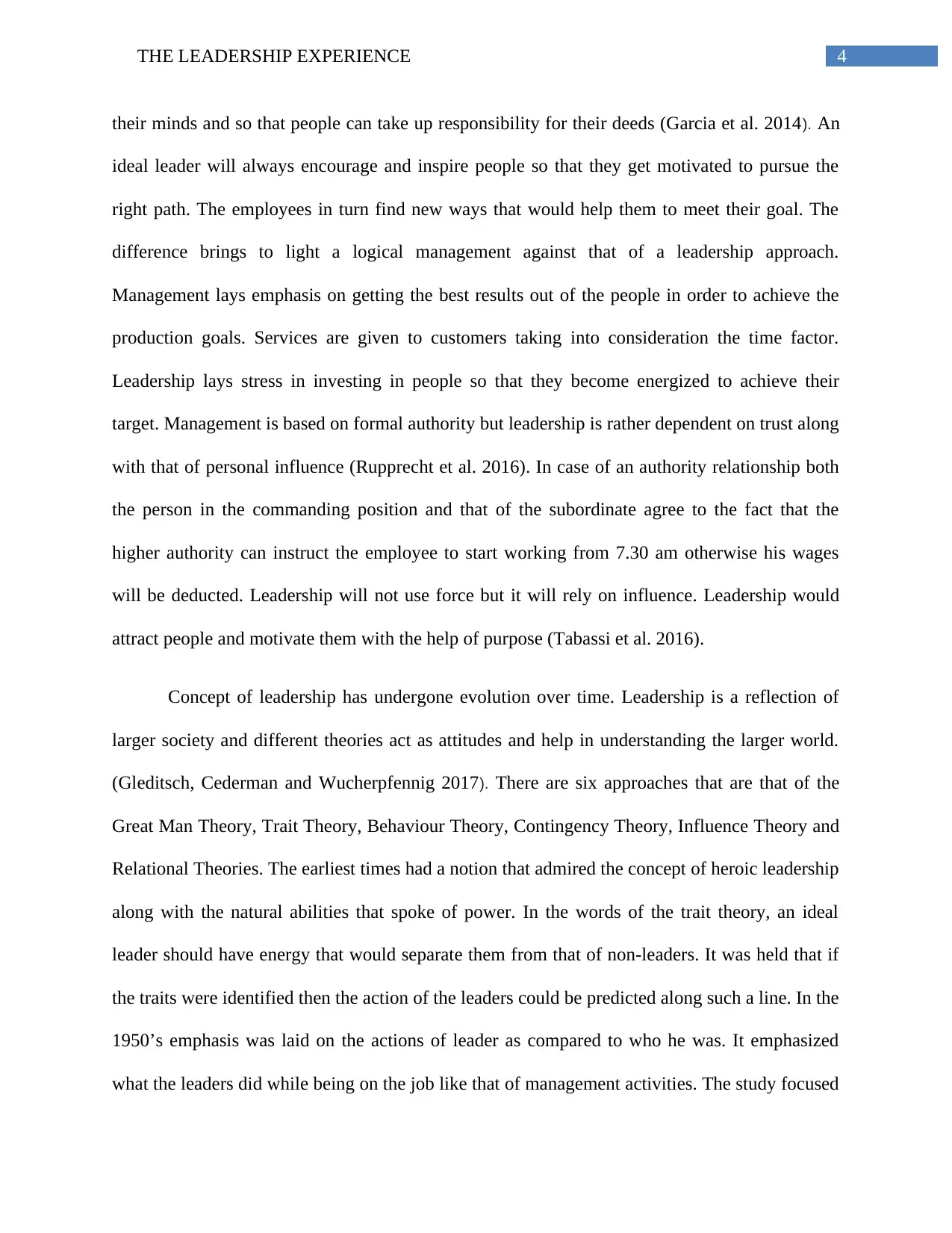
4THE LEADERSHIP EXPERIENCE
their minds and so that people can take up responsibility for their deeds (Garcia et al. 2014). An
ideal leader will always encourage and inspire people so that they get motivated to pursue the
right path. The employees in turn find new ways that would help them to meet their goal. The
difference brings to light a logical management against that of a leadership approach.
Management lays emphasis on getting the best results out of the people in order to achieve the
production goals. Services are given to customers taking into consideration the time factor.
Leadership lays stress in investing in people so that they become energized to achieve their
target. Management is based on formal authority but leadership is rather dependent on trust along
with that of personal influence (Rupprecht et al. 2016). In case of an authority relationship both
the person in the commanding position and that of the subordinate agree to the fact that the
higher authority can instruct the employee to start working from 7.30 am otherwise his wages
will be deducted. Leadership will not use force but it will rely on influence. Leadership would
attract people and motivate them with the help of purpose (Tabassi et al. 2016).
Concept of leadership has undergone evolution over time. Leadership is a reflection of
larger society and different theories act as attitudes and help in understanding the larger world.
(Gleditsch, Cederman and Wucherpfennig 2017). There are six approaches that are that of the
Great Man Theory, Trait Theory, Behaviour Theory, Contingency Theory, Influence Theory and
Relational Theories. The earliest times had a notion that admired the concept of heroic leadership
along with the natural abilities that spoke of power. In the words of the trait theory, an ideal
leader should have energy that would separate them from that of non-leaders. It was held that if
the traits were identified then the action of the leaders could be predicted along such a line. In the
1950’s emphasis was laid on the actions of leader as compared to who he was. It emphasized
what the leaders did while being on the job like that of management activities. The study focused
their minds and so that people can take up responsibility for their deeds (Garcia et al. 2014). An
ideal leader will always encourage and inspire people so that they get motivated to pursue the
right path. The employees in turn find new ways that would help them to meet their goal. The
difference brings to light a logical management against that of a leadership approach.
Management lays emphasis on getting the best results out of the people in order to achieve the
production goals. Services are given to customers taking into consideration the time factor.
Leadership lays stress in investing in people so that they become energized to achieve their
target. Management is based on formal authority but leadership is rather dependent on trust along
with that of personal influence (Rupprecht et al. 2016). In case of an authority relationship both
the person in the commanding position and that of the subordinate agree to the fact that the
higher authority can instruct the employee to start working from 7.30 am otherwise his wages
will be deducted. Leadership will not use force but it will rely on influence. Leadership would
attract people and motivate them with the help of purpose (Tabassi et al. 2016).
Concept of leadership has undergone evolution over time. Leadership is a reflection of
larger society and different theories act as attitudes and help in understanding the larger world.
(Gleditsch, Cederman and Wucherpfennig 2017). There are six approaches that are that of the
Great Man Theory, Trait Theory, Behaviour Theory, Contingency Theory, Influence Theory and
Relational Theories. The earliest times had a notion that admired the concept of heroic leadership
along with the natural abilities that spoke of power. In the words of the trait theory, an ideal
leader should have energy that would separate them from that of non-leaders. It was held that if
the traits were identified then the action of the leaders could be predicted along such a line. In the
1950’s emphasis was laid on the actions of leader as compared to who he was. It emphasized
what the leaders did while being on the job like that of management activities. The study focused
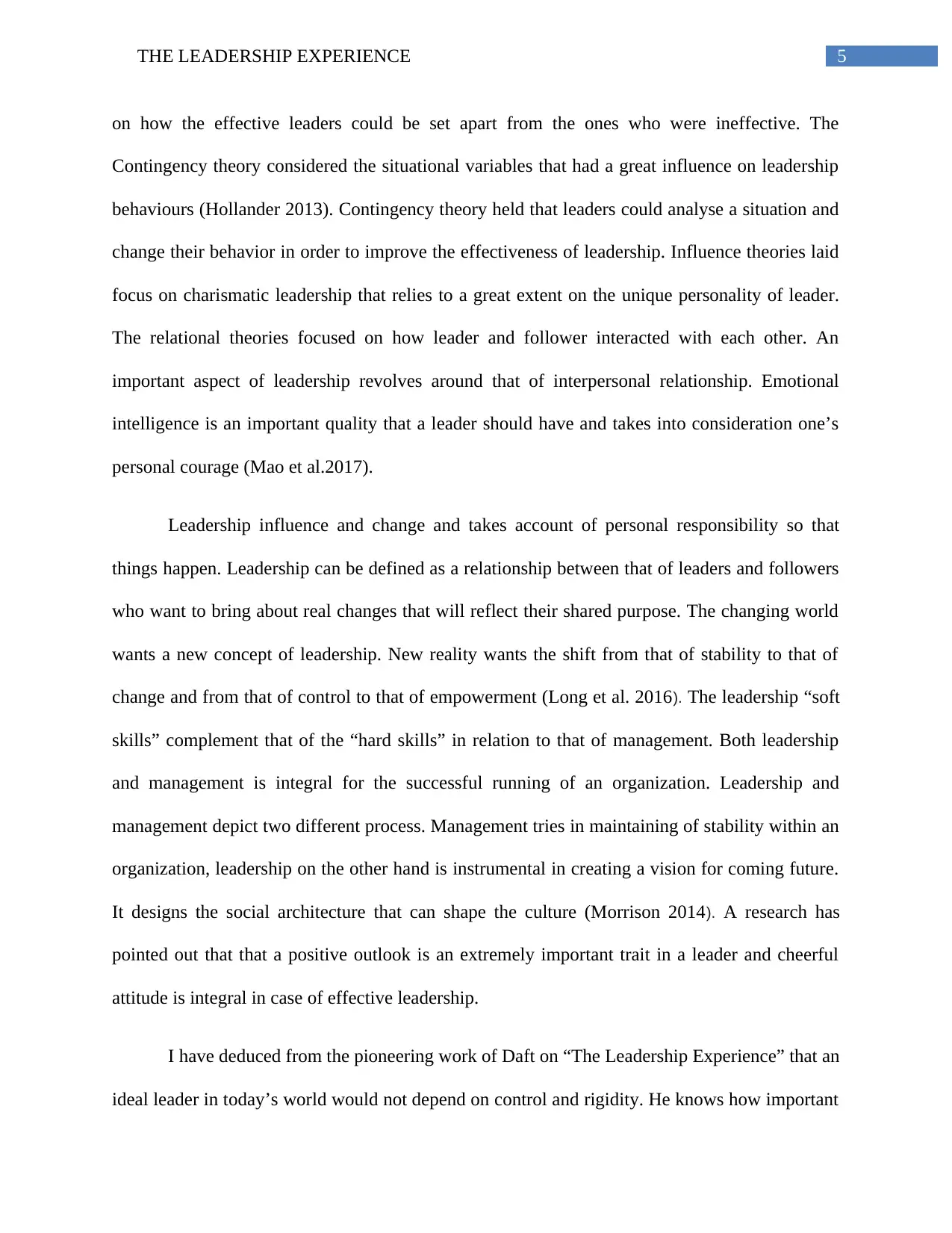
5THE LEADERSHIP EXPERIENCE
on how the effective leaders could be set apart from the ones who were ineffective. The
Contingency theory considered the situational variables that had a great influence on leadership
behaviours (Hollander 2013). Contingency theory held that leaders could analyse a situation and
change their behavior in order to improve the effectiveness of leadership. Influence theories laid
focus on charismatic leadership that relies to a great extent on the unique personality of leader.
The relational theories focused on how leader and follower interacted with each other. An
important aspect of leadership revolves around that of interpersonal relationship. Emotional
intelligence is an important quality that a leader should have and takes into consideration one’s
personal courage (Mao et al.2017).
Leadership influence and change and takes account of personal responsibility so that
things happen. Leadership can be defined as a relationship between that of leaders and followers
who want to bring about real changes that will reflect their shared purpose. The changing world
wants a new concept of leadership. New reality wants the shift from that of stability to that of
change and from that of control to that of empowerment (Long et al. 2016). The leadership “soft
skills” complement that of the “hard skills” in relation to that of management. Both leadership
and management is integral for the successful running of an organization. Leadership and
management depict two different process. Management tries in maintaining of stability within an
organization, leadership on the other hand is instrumental in creating a vision for coming future.
It designs the social architecture that can shape the culture (Morrison 2014). A research has
pointed out that that a positive outlook is an extremely important trait in a leader and cheerful
attitude is integral in case of effective leadership.
I have deduced from the pioneering work of Daft on “The Leadership Experience” that an
ideal leader in today’s world would not depend on control and rigidity. He knows how important
on how the effective leaders could be set apart from the ones who were ineffective. The
Contingency theory considered the situational variables that had a great influence on leadership
behaviours (Hollander 2013). Contingency theory held that leaders could analyse a situation and
change their behavior in order to improve the effectiveness of leadership. Influence theories laid
focus on charismatic leadership that relies to a great extent on the unique personality of leader.
The relational theories focused on how leader and follower interacted with each other. An
important aspect of leadership revolves around that of interpersonal relationship. Emotional
intelligence is an important quality that a leader should have and takes into consideration one’s
personal courage (Mao et al.2017).
Leadership influence and change and takes account of personal responsibility so that
things happen. Leadership can be defined as a relationship between that of leaders and followers
who want to bring about real changes that will reflect their shared purpose. The changing world
wants a new concept of leadership. New reality wants the shift from that of stability to that of
change and from that of control to that of empowerment (Long et al. 2016). The leadership “soft
skills” complement that of the “hard skills” in relation to that of management. Both leadership
and management is integral for the successful running of an organization. Leadership and
management depict two different process. Management tries in maintaining of stability within an
organization, leadership on the other hand is instrumental in creating a vision for coming future.
It designs the social architecture that can shape the culture (Morrison 2014). A research has
pointed out that that a positive outlook is an extremely important trait in a leader and cheerful
attitude is integral in case of effective leadership.
I have deduced from the pioneering work of Daft on “The Leadership Experience” that an
ideal leader in today’s world would not depend on control and rigidity. He knows how important
⊘ This is a preview!⊘
Do you want full access?
Subscribe today to unlock all pages.

Trusted by 1+ million students worldwide
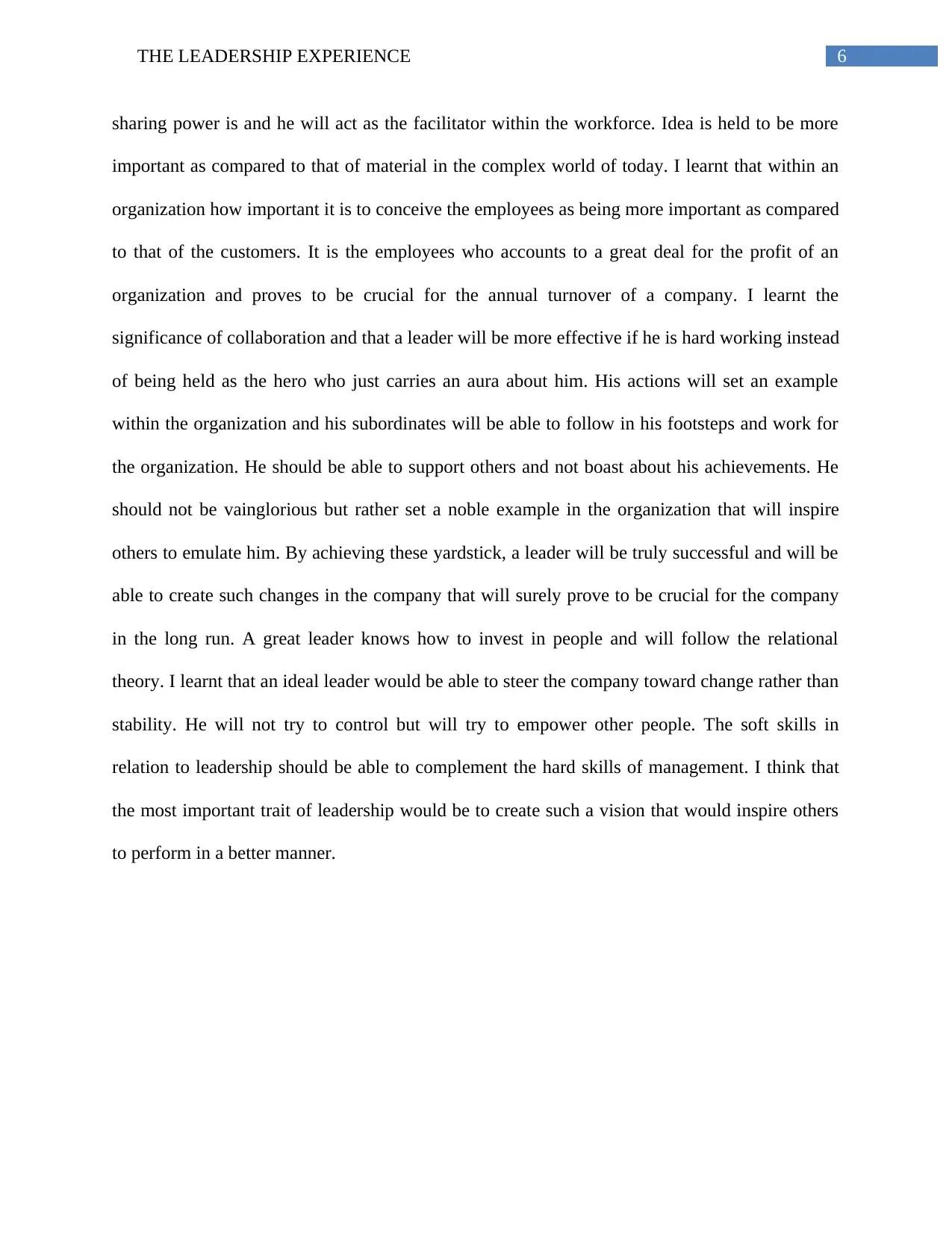
6THE LEADERSHIP EXPERIENCE
sharing power is and he will act as the facilitator within the workforce. Idea is held to be more
important as compared to that of material in the complex world of today. I learnt that within an
organization how important it is to conceive the employees as being more important as compared
to that of the customers. It is the employees who accounts to a great deal for the profit of an
organization and proves to be crucial for the annual turnover of a company. I learnt the
significance of collaboration and that a leader will be more effective if he is hard working instead
of being held as the hero who just carries an aura about him. His actions will set an example
within the organization and his subordinates will be able to follow in his footsteps and work for
the organization. He should be able to support others and not boast about his achievements. He
should not be vainglorious but rather set a noble example in the organization that will inspire
others to emulate him. By achieving these yardstick, a leader will be truly successful and will be
able to create such changes in the company that will surely prove to be crucial for the company
in the long run. A great leader knows how to invest in people and will follow the relational
theory. I learnt that an ideal leader would be able to steer the company toward change rather than
stability. He will not try to control but will try to empower other people. The soft skills in
relation to leadership should be able to complement the hard skills of management. I think that
the most important trait of leadership would be to create such a vision that would inspire others
to perform in a better manner.
sharing power is and he will act as the facilitator within the workforce. Idea is held to be more
important as compared to that of material in the complex world of today. I learnt that within an
organization how important it is to conceive the employees as being more important as compared
to that of the customers. It is the employees who accounts to a great deal for the profit of an
organization and proves to be crucial for the annual turnover of a company. I learnt the
significance of collaboration and that a leader will be more effective if he is hard working instead
of being held as the hero who just carries an aura about him. His actions will set an example
within the organization and his subordinates will be able to follow in his footsteps and work for
the organization. He should be able to support others and not boast about his achievements. He
should not be vainglorious but rather set a noble example in the organization that will inspire
others to emulate him. By achieving these yardstick, a leader will be truly successful and will be
able to create such changes in the company that will surely prove to be crucial for the company
in the long run. A great leader knows how to invest in people and will follow the relational
theory. I learnt that an ideal leader would be able to steer the company toward change rather than
stability. He will not try to control but will try to empower other people. The soft skills in
relation to leadership should be able to complement the hard skills of management. I think that
the most important trait of leadership would be to create such a vision that would inspire others
to perform in a better manner.
Paraphrase This Document
Need a fresh take? Get an instant paraphrase of this document with our AI Paraphraser
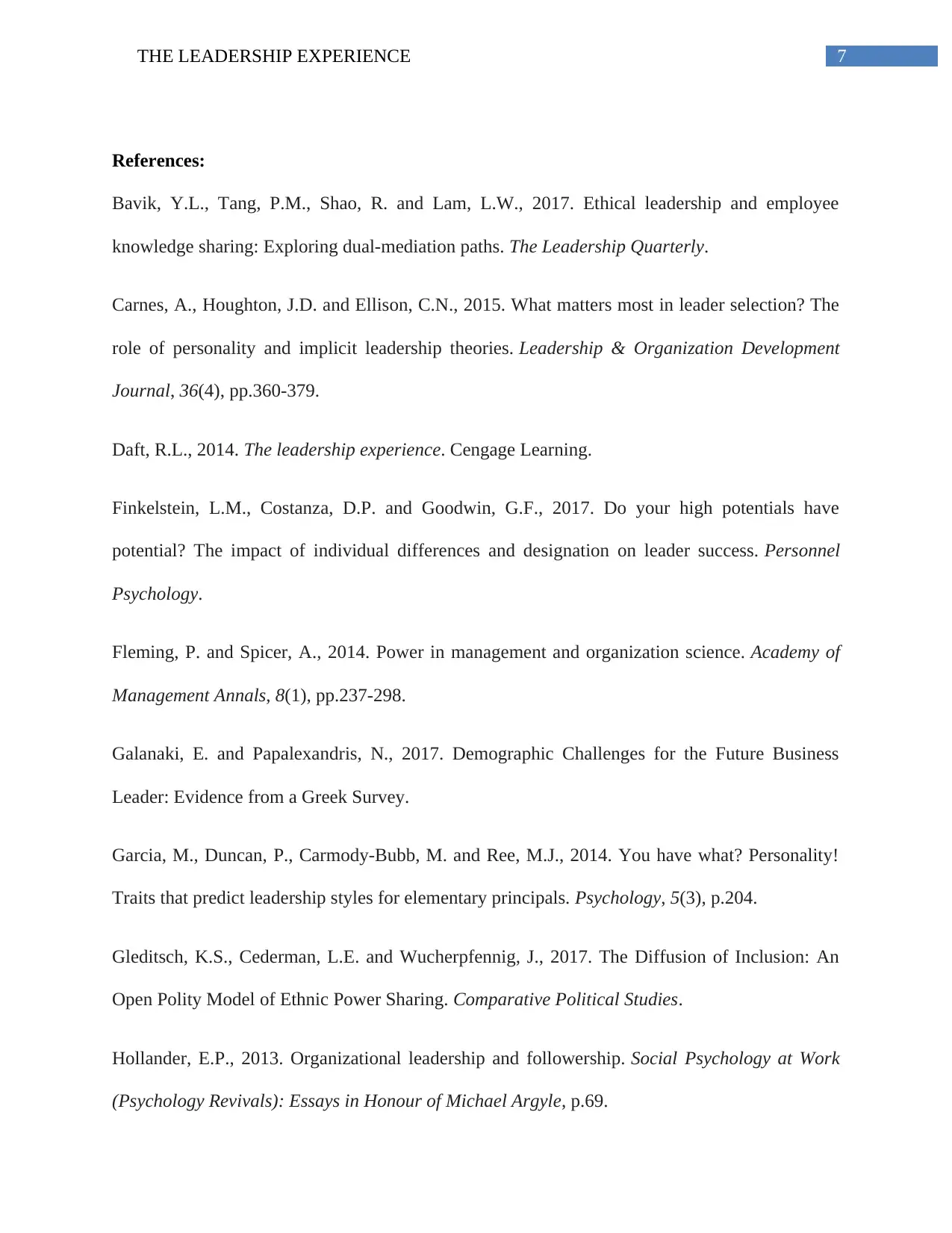
7THE LEADERSHIP EXPERIENCE
References:
Bavik, Y.L., Tang, P.M., Shao, R. and Lam, L.W., 2017. Ethical leadership and employee
knowledge sharing: Exploring dual-mediation paths. The Leadership Quarterly.
Carnes, A., Houghton, J.D. and Ellison, C.N., 2015. What matters most in leader selection? The
role of personality and implicit leadership theories. Leadership & Organization Development
Journal, 36(4), pp.360-379.
Daft, R.L., 2014. The leadership experience. Cengage Learning.
Finkelstein, L.M., Costanza, D.P. and Goodwin, G.F., 2017. Do your high potentials have
potential? The impact of individual differences and designation on leader success. Personnel
Psychology.
Fleming, P. and Spicer, A., 2014. Power in management and organization science. Academy of
Management Annals, 8(1), pp.237-298.
Galanaki, E. and Papalexandris, N., 2017. Demographic Challenges for the Future Business
Leader: Evidence from a Greek Survey.
Garcia, M., Duncan, P., Carmody-Bubb, M. and Ree, M.J., 2014. You have what? Personality!
Traits that predict leadership styles for elementary principals. Psychology, 5(3), p.204.
Gleditsch, K.S., Cederman, L.E. and Wucherpfennig, J., 2017. The Diffusion of Inclusion: An
Open Polity Model of Ethnic Power Sharing. Comparative Political Studies.
Hollander, E.P., 2013. Organizational leadership and followership. Social Psychology at Work
(Psychology Revivals): Essays in Honour of Michael Argyle, p.69.
References:
Bavik, Y.L., Tang, P.M., Shao, R. and Lam, L.W., 2017. Ethical leadership and employee
knowledge sharing: Exploring dual-mediation paths. The Leadership Quarterly.
Carnes, A., Houghton, J.D. and Ellison, C.N., 2015. What matters most in leader selection? The
role of personality and implicit leadership theories. Leadership & Organization Development
Journal, 36(4), pp.360-379.
Daft, R.L., 2014. The leadership experience. Cengage Learning.
Finkelstein, L.M., Costanza, D.P. and Goodwin, G.F., 2017. Do your high potentials have
potential? The impact of individual differences and designation on leader success. Personnel
Psychology.
Fleming, P. and Spicer, A., 2014. Power in management and organization science. Academy of
Management Annals, 8(1), pp.237-298.
Galanaki, E. and Papalexandris, N., 2017. Demographic Challenges for the Future Business
Leader: Evidence from a Greek Survey.
Garcia, M., Duncan, P., Carmody-Bubb, M. and Ree, M.J., 2014. You have what? Personality!
Traits that predict leadership styles for elementary principals. Psychology, 5(3), p.204.
Gleditsch, K.S., Cederman, L.E. and Wucherpfennig, J., 2017. The Diffusion of Inclusion: An
Open Polity Model of Ethnic Power Sharing. Comparative Political Studies.
Hollander, E.P., 2013. Organizational leadership and followership. Social Psychology at Work
(Psychology Revivals): Essays in Honour of Michael Argyle, p.69.
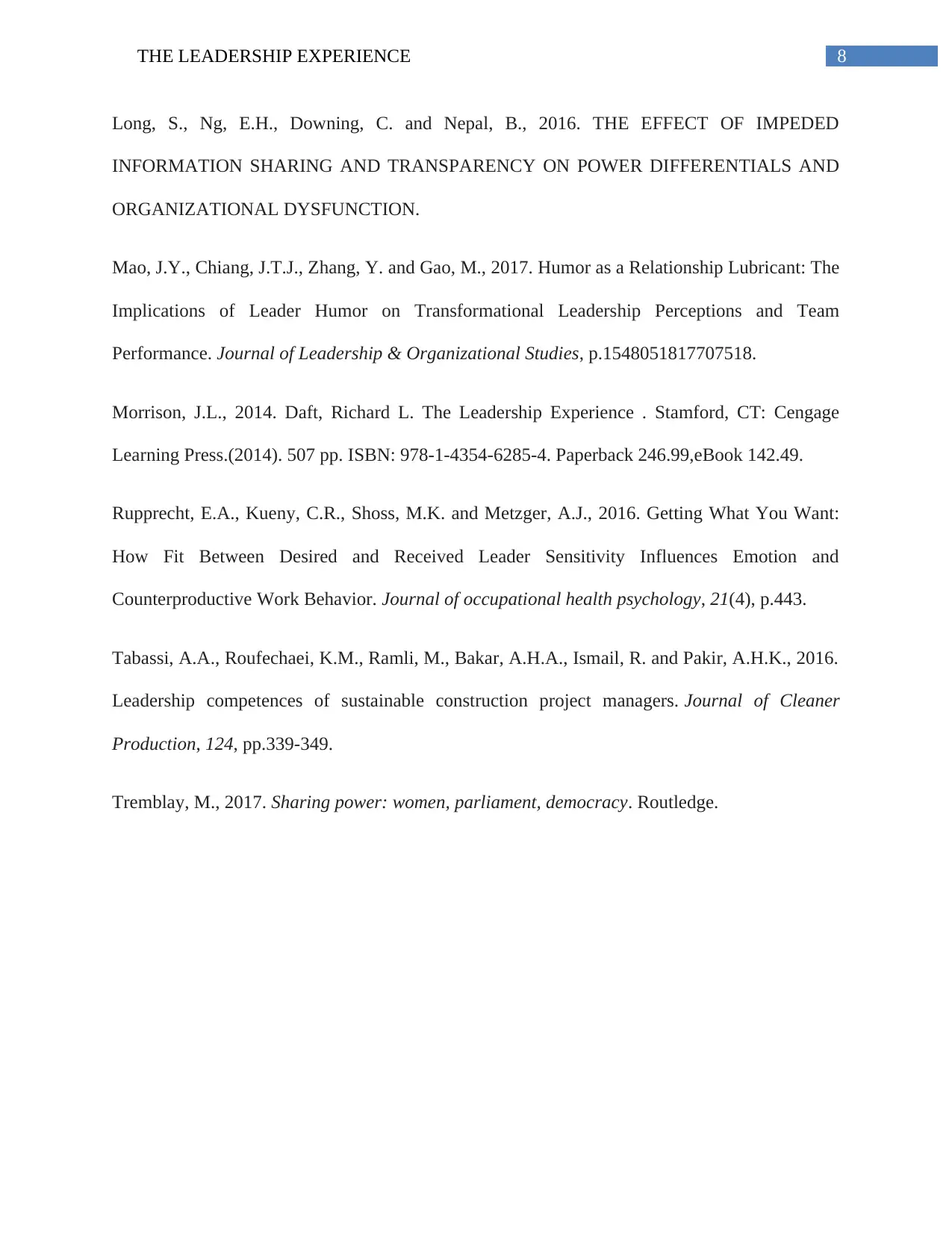
8THE LEADERSHIP EXPERIENCE
Long, S., Ng, E.H., Downing, C. and Nepal, B., 2016. THE EFFECT OF IMPEDED
INFORMATION SHARING AND TRANSPARENCY ON POWER DIFFERENTIALS AND
ORGANIZATIONAL DYSFUNCTION.
Mao, J.Y., Chiang, J.T.J., Zhang, Y. and Gao, M., 2017. Humor as a Relationship Lubricant: The
Implications of Leader Humor on Transformational Leadership Perceptions and Team
Performance. Journal of Leadership & Organizational Studies, p.1548051817707518.
Morrison, J.L., 2014. Daft, Richard L. The Leadership Experience . Stamford, CT: Cengage
Learning Press.(2014). 507 pp. ISBN: 978-1-4354-6285-4. Paperback 246.99,eBook 142.49.
Rupprecht, E.A., Kueny, C.R., Shoss, M.K. and Metzger, A.J., 2016. Getting What You Want:
How Fit Between Desired and Received Leader Sensitivity Influences Emotion and
Counterproductive Work Behavior. Journal of occupational health psychology, 21(4), p.443.
Tabassi, A.A., Roufechaei, K.M., Ramli, M., Bakar, A.H.A., Ismail, R. and Pakir, A.H.K., 2016.
Leadership competences of sustainable construction project managers. Journal of Cleaner
Production, 124, pp.339-349.
Tremblay, M., 2017. Sharing power: women, parliament, democracy. Routledge.
Long, S., Ng, E.H., Downing, C. and Nepal, B., 2016. THE EFFECT OF IMPEDED
INFORMATION SHARING AND TRANSPARENCY ON POWER DIFFERENTIALS AND
ORGANIZATIONAL DYSFUNCTION.
Mao, J.Y., Chiang, J.T.J., Zhang, Y. and Gao, M., 2017. Humor as a Relationship Lubricant: The
Implications of Leader Humor on Transformational Leadership Perceptions and Team
Performance. Journal of Leadership & Organizational Studies, p.1548051817707518.
Morrison, J.L., 2014. Daft, Richard L. The Leadership Experience . Stamford, CT: Cengage
Learning Press.(2014). 507 pp. ISBN: 978-1-4354-6285-4. Paperback 246.99,eBook 142.49.
Rupprecht, E.A., Kueny, C.R., Shoss, M.K. and Metzger, A.J., 2016. Getting What You Want:
How Fit Between Desired and Received Leader Sensitivity Influences Emotion and
Counterproductive Work Behavior. Journal of occupational health psychology, 21(4), p.443.
Tabassi, A.A., Roufechaei, K.M., Ramli, M., Bakar, A.H.A., Ismail, R. and Pakir, A.H.K., 2016.
Leadership competences of sustainable construction project managers. Journal of Cleaner
Production, 124, pp.339-349.
Tremblay, M., 2017. Sharing power: women, parliament, democracy. Routledge.
⊘ This is a preview!⊘
Do you want full access?
Subscribe today to unlock all pages.

Trusted by 1+ million students worldwide
1 out of 9
Related Documents
Your All-in-One AI-Powered Toolkit for Academic Success.
+13062052269
info@desklib.com
Available 24*7 on WhatsApp / Email
![[object Object]](/_next/static/media/star-bottom.7253800d.svg)
Unlock your academic potential
Copyright © 2020–2025 A2Z Services. All Rights Reserved. Developed and managed by ZUCOL.





